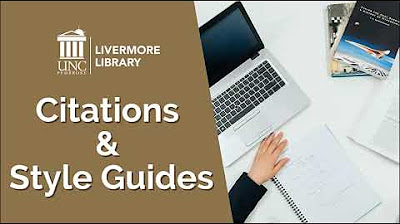Sitasi dan Referensi
Summary
TLDRIn this lecture, Ananda Putri Yani explains the essential aspects of citation and reference in academic writing. The discussion covers the importance of accurate citations, differentiating between direct and indirect quotes, and the correct formatting styles, specifically the APA style. Key points include the rules for citing sources, types of citations (short and long direct quotes, paraphrasing), and how to format references in academic papers. The lecture also emphasizes the proper use of in-text citations and reference lists, with examples of how to cite books, journals, and articles. Students are encouraged to review the material and complete a quiz.
Takeaways
- 😀 Citations, also known as 'kutipan' or 'citasi', are essential for acknowledging the work of others in academic writing.
- 😀 There are two main types of citations: direct (exact quotes) and indirect (paraphrased content).
- 😀 Direct citations must be used for fixed forms such as legal rules, proverbs, scientific statements, and religious texts.
- 😀 Indirect citations, also called paraphrasing, involve rewriting the source content in one's own words without altering its meaning.
- 😀 Direct citations shorter than or equal to four lines are included directly in the text, enclosed in quotation marks.
- 😀 Direct citations longer than four lines are formatted separately from the body text, indented by seven characters, and single-spaced.
- 😀 Indirect citations (paraphrasing) retain the original meaning of the content but are reworded in the writer's own language.
- 😀 References list sources such as books, journals, and articles, supporting the content in academic writing and research.
- 😀 The APA (American Psychological Association) style is used for formatting both in-text citations and the references list.
- 😀 The key components of an APA citation include the author(s), publication year, title of the source, and publisher or journal details.
- 😀 When citing books in APA style, the title is italicized, and when citing articles, only the journal title is italicized, not the article title.
Q & A
What is the definition of 'citation' according to the script?
-Citation, according to the script, is referred to as 'kutipan' in Indonesian, which means a reference or quotation from another source. It involves directly or indirectly using someone else's work to support your own.
What are the two types of direct citations discussed in the lecture?
-The two types of direct citations are 'long direct citations' (more than four lines) and 'short direct citations' (less than or equal to four lines).
What is the rule for citing certain types of content directly?
-Certain content, such as laws, scientific statements, proverbs, dialogues, and verses from religious texts, must be cited directly, without paraphrasing, to ensure accuracy and avoid misinterpretation.
What is a paraphrase, and when is it used in citations?
-A paraphrase is when you restate someone else's ideas or information in your own words without changing the meaning. It is used when citing indirectly, as opposed to direct quotes.
How should a short direct citation (less than 4 lines) be formatted?
-A short direct citation should be placed within the text, enclosed in quotation marks, and with the same spacing as the surrounding text.
What are the formatting requirements for a long direct citation (more than 4 lines)?
-A long direct citation should be formatted separately from the rest of the text, indented 7 spaces (or two tabs), with single spacing.
What does the 'ellipsis' (three dots) in a citation represent?
-The ellipsis indicates the omission of unnecessary or irrelevant parts of the original citation. It is used when one wants to shorten a quote without changing its meaning.
What is the role of 'references' in academic writing as explained in the lecture?
-References are the sources of information or theories that students include in their academic papers, such as journals, books, or theses. They are listed in the reference list or bibliography at the end of the paper.
How should references be formatted in the APA style?
-In APA style, references should list the author's last name first, followed by the year of publication in parentheses, the title of the work (italicized for books, not for journal articles), and the publisher or the journal name, along with other relevant details like volume, issue, and DOI or URL.
How should an author's name be written in the reference list according to the script?
-In the reference list, the author's name should be written with the last name first, followed by a comma and the first name (and middle name if available). For example, 'Austin, J.L.' and 'Grace, P.'
Outlines

Esta sección está disponible solo para usuarios con suscripción. Por favor, mejora tu plan para acceder a esta parte.
Mejorar ahoraMindmap

Esta sección está disponible solo para usuarios con suscripción. Por favor, mejora tu plan para acceder a esta parte.
Mejorar ahoraKeywords

Esta sección está disponible solo para usuarios con suscripción. Por favor, mejora tu plan para acceder a esta parte.
Mejorar ahoraHighlights

Esta sección está disponible solo para usuarios con suscripción. Por favor, mejora tu plan para acceder a esta parte.
Mejorar ahoraTranscripts

Esta sección está disponible solo para usuarios con suscripción. Por favor, mejora tu plan para acceder a esta parte.
Mejorar ahora5.0 / 5 (0 votes)






